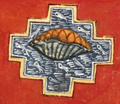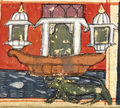No.
Digambara | No.
Śvetāmbara | Name | Image | Dream | Interpretation |
|---|
| 1 | 1 | Airavata |  | White elephant with four tusks, similar to the elephant of the god Indra | Mother would give birth to a child with good character. The four tusk of elephant depicts the four components of Sangha: monks, nuns, laymen and laywomen. |
| 2 | 2 | Vrishabha |  | Bull | The dream foretold the birth of a great religious Teacher who would spread the light of knowledge. |
| 3 | 3 | Simha |  | Lion | Power, strength and fearlessness. The child will be strong as the lion, in overcoming all enemies. |
| 4 | 4 | Lakshmi |  | The goddess of wealth, Lakshmi or Shri | Wealth and prosperity |
| 5 | 5 | Phul-mala |  | Pair of garlands | Popularity and respect |
| 6 | 6 | Chandra |  | Moon | Peace and help to others |
| 7 | 7 | Surya |  | Sun | Supreme knowledge |
| - | 8 | Dhvaja |  | Flag with lion pictured on it flying on golden stick | Leadership |
| 8 | - | Meena-yugma |  | Pair of fishes | Handsomeness |
| 9 | 9 | Purna Kalasha |  | Full jug / pair of full vases with lotuses | Perfect in virtues and would be full of compassion for all living beings. The kalasha is considered auspicious in Dharmic religions. |
| 10 | 10 | Padma Sarovar |  | Lotus pond / celestial lake | Detachment from worldly possessions |
| 11 | 11 | Ratnakar |  | Ocean / rough ocean | Achievement of infinite perception and knowledge, spiritual liberation |
| 12 | - | Simhasana |  | Large, resplendent, golden throne set with bright diamonds and rubies | Son will become the World Teacher |
| 13 | 12 | Deva-Vimana |  | Celestial cheriot palace | Angels in heaven would respect, honor his spiritual teachings |
| 14 | - | Palace |  | The rising residence of Nāgendra, the lord of the devas of the Nāgakumāra clan | Child will be born with clairvoyance |
| 15 | 13 | Ratnadhag |  | Heap of jewels | Virtues and wisdom |
| 16 | 14 | Nirdhumra Agni |  | Smokeless fire | Reform and restoration of religious order. He would burn his karmas and attain salvation. |


















